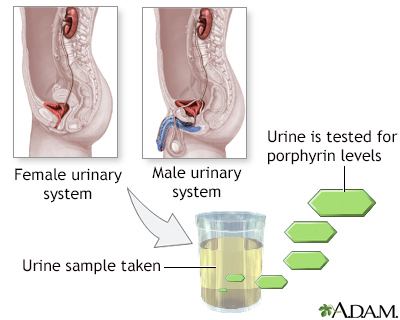Porphyrins urine test
Definition
Porphyrins are natural chemicals in the body that help form many important substances in the body. One of these is hemoglobin, the protein in red blood cells that carries oxygen in the blood.
Porphyrins can be measured in the urine or blood. This article discusses the urine test.
Alternative Names
Urine uroporphyrin; Urine coproporphyrin; Porphyria - uroporphyrin
How the Test is Performed
After you provide a urine sample, it is tested in the lab. This is called a random urine sample.
If needed, your health care provider may ask you to collect your urine at home over 24 hours. This is called a 24-hour urine sample. Your provider will tell you how to do this. Follow instructions exactly so that the results are accurate.
How to Prepare for the Test
Your provider may tell you to temporarily stop taking medicines that may affect the test results. These may include:
- Antibiotics and anti-fungal drugs
- Anti-anxiety drugs
- Birth control pills
- Diabetes medicines
- Pain medicines
- Sleep medicines
Do not stop taking any medicine without first talking to your provider.
How the Test will Feel
This test involves only normal urination and there is no discomfort.
Why the Test is Performed
Your provider will order this test if you have signs of porphyria or other disorders that can cause abnormal urine porphyrins.
Normal Results
Normal results vary depending on the type of porphyrin tested. In general, for a 24-hour urine test of total porphyrins, the range is about 20 to 120 µg/L (25 to 144 nmol/L).
Normal value ranges may vary slightly among different laboratories. Some labs use different measurements or may test different specimens. Talk to your provider about the meaning of your specific test results.
What Abnormal Results Mean
Abnormal results may be due to:
- Liver cancer
- Hepatitis
- Lead poisoning
- Porphyria (several types)
Risks
There are no risks with this test.
Gallery



References
Fuller SJ, Wiley JS. Heme biosynthesis and its disorders: porphyrias and sideroblastic anemias. In: Hoffman R, Benz EJ, Silberstein LE, et al, eds. Hematology: Basic Principles and Practice. 7th ed. Philadelphia, PA: Elsevier; 2018:chap 38.
Hift RJ. The porphyrias. In: Goldman L, Schafer AI, eds. Goldman-Cecil Medicine. 26th ed. Philadelphia, PA: Elsevier; 2020:chap 199.
Riley RS, McPherson RA. Basic examination of urine. In: McPherson RA, Pincus MR, eds. Henry's Clinical Diagnosis and Management by Laboratory Methods. 24th ed. Philadelphia, PA: Elsevier; 2022:chap 29.